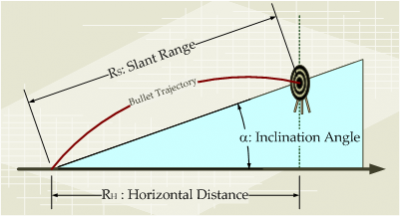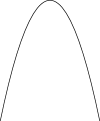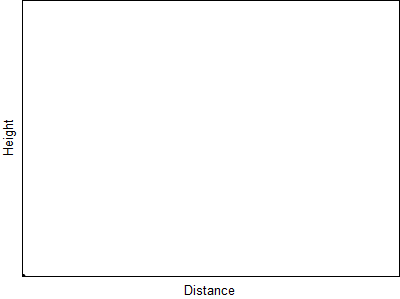Difference between revisions of "Trajectory"
(→The basics) |
Revision as of 17:24, 12 May 2012
In the simplest terms, trajectory is "the path of a moving object that it follows through space." The object in question can be absolutely anything at all; from a rock that a kid throws, to a satellite launched by NASA.
Now, because this is a gun-oriented online encyclopedia, we're obviously not going to get into all the stuff about control theory, the paths of planets and comets through space, orbital behaviours, or any of that other geeky stuff (if you really do feel the need to bang your head against all that math, you can check out this article on Wikipedia's website). We're just going to stick with covering the topic of trajectory as it applies to things that we do: primarily, trajectory as it concerns the behaviour of a projectile and the things that can affect it.
The United States Department of Defense and NATO both define a ballistic trajectory as "a trajectory traced after the propulsive force is terminated and the body is acted upon only by gravity and aerodynamic drag."[1]
Contents |
The basics
Probably the simplest example of a trajectory is the path of something you throw, like a baseball or a rock. To oversimplify things, the object moves only under the influence of a uniform gravity, and nothing else. Imagine lobbing a rock a short distance on the moon and you get the idea. The trajectory takes the shape of a parabola; it goes up, it peaks, and then it goes back down again at the same rate (sort of like the picture on the right). All of this is fine and dandy if you live on the moon.We, however, don't live on the moon. Some folks might, but we don't. Here on the planet Earth, the path (trajectory) of a projectile is affected by everything from air resistance (like windage, barometric pressure and humidity) to variances in gravity -- That's right: the force of gravity isn't the same everywhere on Earth (and here we told you we weren't going to get too geeky)!
Put all of this stuff together, and we get the discipline of ballistics.
Affecting factors
A number of things will affect trajectory (and thus your accuracy), besides your own skill. Some things, like drag and windage, will affect even the casual rifle marksman. Other things, like gravity and the Coriolis effect, are extremely unlikely to be of any concern to anyone dealing with ranges of less than a mile (1.6 km).
Drag
In fluid dynamics, drag (sometimes called fluid resistance) is "the force that resists the movement of a solid object through a fluid." It doesn't matter what the fluid in question is, whether a liquid or a gas (like air). Drag is the friction that acts against a projectile as it's getting where it's going and can be affected by humidity, temperature, bullet shape, altitude and barometric pressure.
Altitude and pressure
As barometric pressure increases, like when a high pressure weather system moves through, the density of the air goes up and the force of drag on a bullet increases. This will have several effects on accuracy, all of which will, naturally, become more pronounced as range increases:
- Greater resistance will mean that the energy of a bullet will be spent more quickly, resulting in shorter effective range.
- As the projectile loses velocity quicker, bullet drop will increase, resulting in a lower point of impact on the target.
- The decrease in velocity can also result in the effects of windage becoming more pronounced, requiring greater compensation in aiming.
The reverse of all these is true when shooting under lower than normal atmospheric pressures: range increases, bullet drop decreases, etc.
Altitude can also have a direct impact on barometric pressure because the air is thinner at higher elevations than it is at sea level. It could therefore be assumed that a bullet fired from the top of Mount Everest (the highest point of land on Earth), for example, would experience less drag than one fired in Death Valley (the lowest point). This would be a good analogy if not for one thing: humidity.
Temperature and humidity
The problem with the analogy above is that it doesn't take humidity into account. While Death Valley may be a lot lower than the top of Everest and have a higher barometric pressure, Death Valley has one thing going for it: it is one of the hottest and driest places on the planet.
Temperature affects drag because colder temperatures mean an increase in air density. Think back to your high school science class: things expand when they get hot and contract when they get cold. The mass of the thing does not change, only the volume does. It's the same with air except that instead of the volume changing, the mass that's in that volume does. This means that a bullet has to travel through a thicker medium to get where it's going and will lose its energy that much faster.
Humidity also makes a difference because, as the air holds more moisture, it acquires more mass and becomes thicker and more resistant to objects passing through it.
Bullet design
Because not all bullets are equally aerodynamic, different bullets will experience different levels of drag as they pass through the air. For example: wadcutters make nice neat holes that make scoring easier in competitions, but they aren't anywhere near as aerodynamic as spitzers are. Likewise, a musket ball may start out with a lot of "oomph" behind it as it leaves the muzzle, but its spherical shape makes for some sorry aerocynamics, which results in severe drag susceptibility -- one of the reasons (but not the only one) for their very limited range.
The planet
Believe it or not, the planet can mess with your aim. That's the bad news.
The good news is that (unless your name is Rob Furlong or Craig Harrison or something like that) the chances of you ever doing anything at a range long enough to make any of the stuff in this section matter are virtually nil. This section is here not so much because it's practical as because these are just a few cool things to know (here we go getting geeky again).
Gravity
As a certain animated coyote found out, after numerous trips over one cliff or another...- Gravity: It's not just a suggestion, it's the law.
No matter what kind of kick-ass muzzle velocity you manage to get out of that cool new load you managed to cook up, sooner of later gravity's going to pull it down. And, contrary to popular belief, the Earth's gravitational field is not constant over all the planet's surface, for two main reasons.
The first reason is how far you are form the planet's core:
- "...the strength of this field at any given point is proportional to the planetary body's mass and inversely proportional to the square of the distance from the center of the body."
Getting back to high school (geography class, this time), the Earth is not perfectly round. Besides having bumps and dents (aka mountains and valleys) all over the place, it's also a bit squashed along the longitudinal (north-south) axis. This means that the diameter of the earth is a bit less from pole to pole than it is from opposite points on the equator. This is often called the "equatorial bulge" (something we can all develop if we're not careful).
Gravity also decreases with altitude, since greater altitude means greater distance from the Earth's centre. All other things being equal (even though they usually aren't), an increase in altitude from sea level to the top of Mount Everest (8,850 metres) causes a weight decrease of about 0.28%. Another thing that fiddles with apparent weight is the decrease in air density at high altitudes (mentioned above), which lessens an object's buoyancy.
The second reason is centripetal force:
Another reason for lesser apparent gravity at the equator is that the surface of the Earth is rotating: some of the gravitational force, therefore, provides centripetal force, keeping objects on the surface (and indeed the surface itself) moving in a circular motion. Because rotation velocity (and, thus, centripetal force) decreases the closer you are the poles, local gravity (g) increases from 9.789 m·s−2 at the equator to 9.832 m·s−2 at the poles.
In other words: on average, ignoring air resistance (see Drag, above), an object falling freely near the earth's surface increases its velocity with 9.8 m/s (32.2 ft/s or 22 mph) for each second of its descent. But really, it depends on where you are, and more gravity means more downward pull on your shot. Of course this means diddly if you're plinking at 50 yards or so, but if your target is 1500m away, little things add up...
- (For some information on what kind of effect gravity can actually have on the average shooter's activities, see the rifleman's rule article.)
The Coriolis effect
Everybody knows that the Earth spins; not everybody thinks about the effect this can have on marksmanship. Artillery officers are aware of this but few riflemen ever take the time to consider it (likely because few are good enough to need to). Because a bullet is no longer anchored to the Earth's rotation once it leaves the barrel, it follows a clean trajectory towards where it was aimed (all other things being equal) but the planet -- and the target -- keeps on spinning underneath the projectile. The practical result of all this is that, when shooting at a long enough range, you actually have to lead a stationary target!
The observable results of the Coriolis effect become more pronounced on north-south shooting and less pronounced on east-west shooting as you get closer to the equator. The opposite is also true as you approach one of the poles. However, the effects are NOT perceived in opposite directions in the northern and southern hemisphere.
For example: If you are just north of the equator and fire a shot in a southerly direction, the shot will seem to drift to the right as it gets further away. If you turn around and shoot to the north, the shot will seem to drift to the left. The same thing happens if you are just south of the equator: the path of the projectile will always seem to drift to the west. The shot's not drifting at all; the planet is moving under the bullet and if the planet moves, it's probably going to take your target with it.
Another interesting factoid here is that, because the planet spins to the east, you'll get better range shooting to the west than you will to the east. This will also be more noticeable as you get closer to the equator.
Have fun if you ever get good enough with your rifle to actually need any of this information.
What's a day at the range without a little astrophysics and spatial relativity, eh?
References
- ↑ Ballistic trajectory - Defense Technical Information Center



